HIGHLIGHTS
Moderate and Aggressive Investors
- Characteristics
- Risk Tolerance
- Return Requirement
- Liquidity Needs
- Time Horizon
- Investment Options:
- Income Funds
- Repurchase Agreements (Repos)
- Fixed Deposits
- Bonds
- Balanced Mutual Funds
- Equity Mutual Funds/ Index ETFs
- Growth Stocks
This week, we at Bourse conclude our two-part series designed to help individuals identify investment options that align with their unique investor profile. By understanding one’s risk tolerance, investors can make more confident decisions as they work toward building long-term wealth. In this article, we shift our focus to the Moderate and Aggressive Investor. These types of investors typically exhibit a greater willingness to accept risk in exchange for potentially higher returns. We discuss the typical traits of Moderate and Aggressive Investors, highlight suitable investment options, and provide an overview of portfolio strategies that match their investment objectives.
What’s Your Investor Profile?
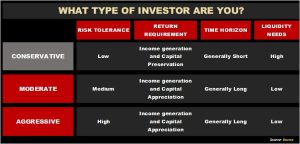
Reinforcing the three investor profiles outlined in the first part of the series, investors can be categorized into three (3) basic profiles: Conservative, Moderate and Aggressive, based on their risk tolerance, return requirement, investment time horizon and liquidity needs.
As outlined in Part 1 of the series, the Conservative Investor prioritizes income generation and capital preservation, with limited focus on capital appreciation. The Conservative Investor usually focuses on loss minimization, as opposed to return maximization.
The Moderate Investor, as the name suggests, is prepared to take on moderate risk in exchange for generating returns through a combination of income generation and capital appreciation. Some losses and/or fluctuations to the invested funds are tolerable for this investor.
The Aggressive Investor, in order to maximize returns, is prepared to take greater risk. This investor is typically very focused on growing wealth at a faster rate, cognizant that his/her investments may fluctuate significantly in value.
Are You a Moderate or Aggressive Investor?
While moderate and aggressive investors both seek capital growth, the degree of risk they are willing to take and the strategies they employ vary.
- Risk Tolerance. Moderate investors are open to some portfolio volatility in exchange for higher potential returns, which in turn broadens the types of investment solutions available. Aggressive investors are willing to accept an even higher degree of risk, which creates the ability to allocate a larger portion of their portfolios to investments whose values may fluctuate considerably over time and throughout investment cycles.
- Return Requirement. Moderate investors seek to grow wealth through a mix of capital gains and income, often choosing value stocks and medium to long-term bonds. Often seeking a ‘goldilocks’ allocation that offers a return profile between low and aggressive risk, moderate investors often seek to generate returns with a mix of equities, bonds and some money market instruments. Aggressive investors, on the other hand, typically tilt their portfolios toward a higher proportion of growth stocks, small-cap companies, and IPOs. Within their (usually) lower allocation to fixed income instruments, they may opt for non-investment (speculative) grade issuers with more cyclical business but offering higher yields.
- Liquidity. Moderate investors generally have lower liquidity needs, as they are prepared to keep the riskier parts of their portfolios invested through market and economic cycles. Compared to conservative investors, they allocate less to highly liquid assets. Aggressive investors generally have the lowest liquidity needs, with the majority of their portfolios positioned for long-term growth and a minimal portion held in liquid investments. This approach supports their focus on maximizing returns over time.
- Time Horizon. With lower liquidity needs and a focus on capital growth, the Moderate and Aggressive Investors typically have a longer investment time horizon. Accordingly, medium-term bonds (5–10 years) and equities are often a staple of these portfolios, with the difference being the inherent riskiness of the securities held (investment vs. non-investment grade bonds, large cap vs. small cap stocks etc.)
Who should consider Moderate or Aggressive Investing?
While the lure of higher returns of Moderate and Aggressive strategies may appeal to investors, it is important to consider your financial goals, risk tolerance and importantly, investment time horizon. Below are some common descriptions of persons who may be most suited to moderate or aggressive investing.
- Moderate Investors, such as working professionals or pre-retirees are more often capable of investing over a medium to long-term horizon. This provides a reasonable runway to recover from economic or market downturns, making balanced, diversified portfolios a suitable option.
- Aggressive Investors are more often typified by younger individuals or those with naturally higher risk tolerances. With longer investment time horizons, they are better positioned to ride out market volatility and benefit from long-term growth potential.
Determining whether a Moderate or Aggressive investment style is suitable for you is highly dependent on your individual circumstances.
Investment Options
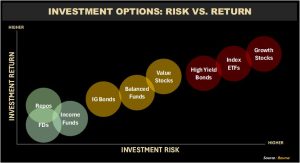
Beyond conservative options like income mutual funds, fixed deposits, repos, and dividend stocks, the Moderate Investor considers value stocks, investment-grade bonds, balanced mutual funds, and equity index ETFs for inclusion in a portfolio. The Aggressive Investor builds on this by allocating portions of their portfolio to higher-risk, higher-return assets including but not limited to growth stocks and high-yield bonds.
Bonds are fixed income instruments where investors lend money to issuers—such as governments or corporations—in exchange for regular interest payments and the return of principal at maturity. Bond tenors typically range from 3 to 30 years and vary in risk based on credit ratings. Moderate Investors may prefer medium-term, high credit quality bonds for balanced returns, while Aggressive Investors may opt for lower credit quality rated bonds with higher return potential.
Balanced Mutual Funds—also known as Growth & Income Funds—offer a mix of stocks, bonds, and other securities within a single portfolio, making them a highly convenient, professionally managed solution to building a moderate or aggressive portfolio. The difference would lie in the percentage allocation to these types of solutions, with the moderate investor usually having a higher allocation invested in balanced funds relative to aggressive investors. Retirement Mutual Funds, which follow a similar balanced approach, may also appeal to Moderates aiming for steady long-term growth.
Equity Mutual Fund/ Equity ETFs
An equity mutual fund is a type of mutual fund that invests its assets generally in stocks or shares of various companies for the long term to benefit the investors. Equity Mutual Funds traded over stock exchanges are referred to as Equity Exchange Traded Funds or Equity ETFs.
For the Moderate investor, Equity Mutual Funds/ETFs are another useful tool to construct a balanced portfolio with ready-made diversification benefits. A portion of the portfolio may be focused on broad market ETFs, which provide a balanced exposure across regions or sectors.
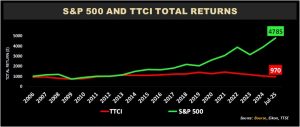
Investors seeking broad market exposure and diversification should think longer-term about their investment horizon. Moderate and Aggressive investors are willing to take more risk though equities in exchange for potentially higher returns. Just how much additional return is available through equity investments?
Looking at the S&P500 Index performance from December 2006 to July 2025, despite multiple extraordinary events, economic cycles and other market-moving factors, the S&P500 Index grew at an annualized rate of 8.1% (excluding dividends) over the period. The Trinidad and Tobago Composite Index (TTCI), during the same period, remained relatively flat on an annualized basis.
Put differently, an investor buying US$1,000 in the S&P 500 index at the start of 2006, would have a position worth approximately US$4,785 (excluding dividends) at the end of July 2025. In contrast, a similar investment of TT$1,000 in the TTCI over the same period would now be worth approximately TT$970.
Investor Profile Allocations
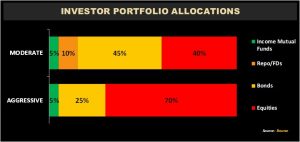
A sample Moderate Investor portfolio allocation might comprise 5% in Income Mutual Funds, 10% in Repos/FDs, 45% in Government and Corporate bonds and 40% in Equities. When considering prevailing returns on each of these types of investments, the weighted return on the Moderate portfolio would range between 5.0% – 5.25% annually.
The Aggressive Investor portfolio allocation might consist of a 5% weighting in Income Mutual Funds/ Repos/FDs, 25% in higher-yielding bonds and 70% in Equities. The expected weighted return on such a portfolio would typically range between 6.5% – 7.0% annually.
A Conservative, Moderate and Aggressive investor’s sample portfolio yields an average of 3.8%, 5.25% and 7.0% respectively, all effectively outpacing the five-year average inflation in T&T of 2.7%.
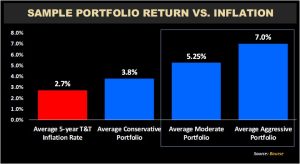
In addition to choosing the most appropriate investments from a risk-perspective, we reiterate the importance of (i) building a well-diversified portfolio, (ii) incorporating investments in foreign currencies, if possible and (iii) adopting a long-term approach to your investment portfolio.
Still not sure whether you are a Conservative, Moderate or Aggressively minded investor? Reach out to an experienced advisor to help make the most informed investment decisions and get started or improve your investment journey.
This document has been prepared by Bourse Securities Limited, (“Bourse”), for information purposes only. The production of this publication is not to in any way establish an offer or solicit for the subscription, purchase or sale of any of the securities stated herein to US persons or to contradict any laws of jurisdictions which would interpret our research to be an offer. Any trade in securities recommended herein is done subject to the fact that Bourse, its subsidiaries and/or affiliates have or may have specific or potential conflicts of interest in respect of the security or the issuer of the security, including those arising from (i) trading or dealing in certain securities and acting as an investment advisor; (ii) holding of securities of the issuer as beneficial owner; (iii) having benefitted, benefitting or to benefit from compensation arrangements; (iv) acting as underwriter in any distribution of securities of the issuer in the three years immediately preceding this document; or (v) having direct or indirect financial or other interest in the security or the issuer of the security. Investors are advised accordingly. Neither Bourse nor any of its subsidiaries, affiliates directors, officers, employees, representatives or agents, accepts any liability whatsoever for any direct, indirect or consequential losses arising from the use of this document or its contents or reliance on the information contained herein. Bourse does not guarantee the accuracy or completeness of the information in this document, which may have been obtained from or is based upon trade and statistical services or other third-party sources. The information in this document is not intended to predict actual results and no assurances are given with respect thereto.”
